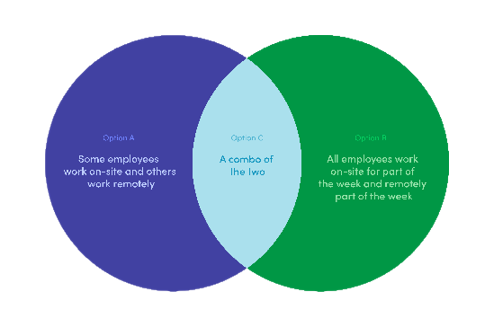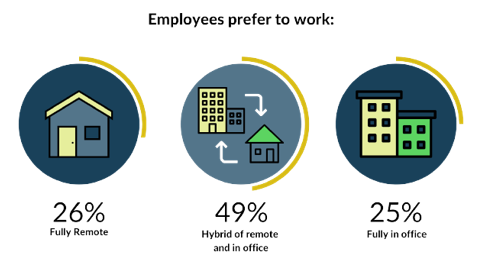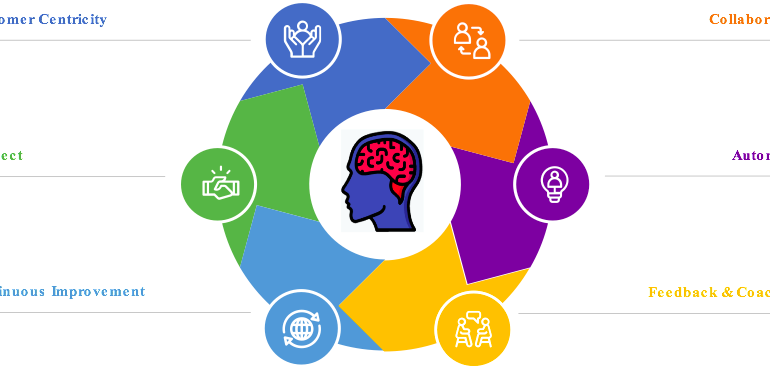As the world came to a halt owing to the COVID-19 pandemic, many of us were forced to try out a new employment arrangements. Work-from-home and remote-working policies have been implemented.
The nature of some firms’ work, however, just does not allow for a 100% remote work policy! The solution was to find a middle ground between the two—a compromise that gave rise to the hybrid workplace paradigm.
While offering a hybrid model is very simple, making it work for your company involves a lot of effort and planning, as well as additional support for employees who may struggle to navigate the new decentralized, multi-space manner of working.
In a hybrid environment, “the possibility of a detached organization offers a genuine concern,” according to a recent analysis by Temporal. “The significance of listening and a supportive, trusting culture will play a vital role during these transitory periods – both for post-pandemic change and beyond,” the report continues, “to ensuring that an organization evolves constructively and for all.”
Before getting into this, let’s first know first what Hybrid Model is.
What is Hybrid-Work Model?

A hybrid work style combines on-site and remote work to give you the best of both worlds. For example, an employee could work from home three days a week and go to the office the other two days. Alternatively, there may be certain days when managers demand employees to attend in-person meetings.
Employees can have the flexibility they had when working from home while still maintaining those crucial face-to-face contacts with co-workers that are so critical for cooperation and wellbeing.
But. Why Hybrid Work?
Due to faster internet, cloud collaboration tools, and a greater emphasis on creating a healthy work-life balance, hybrid work has been gaining in popularity for a long now. But it truly came into its own during the epidemic, when firms all over the world were under pressure to cut links with traditional working practices.
Although not every company can use a hybrid model, it is becoming the norm in several industries, such as banking and technology. Companies as diverse as Facebook, Microsoft, PwC, and KPMG are already embracing hybrid work.
And also, according to the survey shown below, most people preferred the hybrid work model over any option.

What are the advantages of Hybrid Work?
Increased Productivity: One of the most important lessons learned from the pandemic is that working at a designated desk is not always more productive than working at your kitchen table or at a nearby coffee shop. As a result, one of the most significant benefits of hybrid workplace models is enhanced productivity.
According to Stanford research, employees are 13 percent more productive at home. According to another survey of over 12,000 employees, 75% of those who switched to homework due to the pandemic were at least as productive as those who worked in the office.
Increased Flexibility and Agility: By definition, hybrid working is adaptable, and it works well with other flexible workplace models. Activity-based work, agile work, and office neighborhoods are all easily integrated into a hybrid workplace. All of these methods of working are intended to empower employees. Employees should have more flexibility in terms of how, when, and where they work.
This enhanced flexibility aids hybrid office spaces in attracting new employees while also keeping current employees satisfied and engaged.
Better Use of Space: Hybrid offices are more efficient in several ways, including space utilisation. Offices can suddenly think of more imaginative and effective uses of their real estate when they don’t need rows and rows of cubicles and conference rooms.
Hybrid workplaces, for example, can more easily implement activity-based workspaces. Companies like Microsoft, Pixar, LinkedIn, and Uber have all adopted activity-based workspace design as the future of work. It’s another tool to help recruit new personnel and promote a compelling business culture by providing fresh and appealing workspaces.
Increased Cost Cuttings: Because there are fewer people working in a mixed work environment, organisations can save money on real estate and other expenses. This is true as long as facility managers (FMs) better plan the area.
When AT&T first utilised virtual office work for some team members in the early 2000s, it saved its annual real estate costs by $30 million. Meanwhile, IBM has saved
$50 million in real estate expenditures, Sun Microsystems has saved $68 million per year, while Dow Chemical and Nortel have saved 30% on non-real estate costs.
Improved Employee Experience: The total well-being of employees is referred to as employee experience. More flexible and hybrid work alternatives are usually beneficial.
Hybrid employment delivers a higher level of autonomy and job satisfaction by putting more decision-making authority in the hands of people. This can result in a more efficient workflow as well as a better work-life balance. Many employees have embraced hybrid since it allows them to avoid the burnout of long commutes and the boredom of the sameness, enhancing the employee experience even more.
Hybrid Work Model Disadvantages:
Communication Issues: In older offices, communicating was a given. Whether in organised, easy-to-organize meetings, hallways, over cubicle walls, or over the famed water cooler, it happened easily and spontaneously.
When employees don’t share a physical area, though, actual real-time communication is more challenging.
As a result, one of the main issues FMs will face in the future is misinterpretation and missed communications between asynchronous hybrid teams. To establish meaningful relationships across hybrid teams, they’ll have to use the greatest hybrid working tools.
Integrating platforms like Microsoft Teams, Slack, and Zoom Meet can make it easier for everyone on your team to communicate in real-time, and they’re here to stay.
Division between Employees: Another drawback of the hybrid model is that it may create splits among employees, particularly between in-office and remote workers.
This can sometimes be a straightforward issue with a straightforward solution.
Meanwhile, employees who work solely in the office may dislike co-workers who appear to have greater freedom.
Difficulty Implementing: As these hybrid work model disadvantages demonstrate, this is a complex paradigm that must be done appropriately to be successful. Without an effective facilities management staff to facilitate remote work, increased reliance on technology can be challenging.
Maintaining cyber security for remote employees can be difficult. In addition, as the number of charging stations and wifi hotspots in a facility grows, so do the hazards to building automation systems.
Harder for new recruits to learn from more experienced staff: This is one of the most difficult aspects of hybrid functioning. If new recruits only spend limited time in the office with coworkers, it might be tough for them to learn the ropes. Not only that but developing ties with coworkers is considerably more difficult if they don’t communicate in person. Isolation and frustration might result as a result of this.
Impact on Culture: When people are not present all of the time, the sense of belonging in an organisation may be diminished. Remote workers may feel less connected, out of the loop, and unable to give as much, leading to a sense of alienation. All team members must be invested in each other’s and the company’s success.
The benefits and drawbacks of a hybrid work model aren’t always black and white. The success of the hybrid work paradigm is largely determined by how successfully it is implemented, and the tools utilised to do it. A company culture that trusts employees and supports their well-being is just as important as the right hybrid working tools.
There’s a reason why so many businesses are adopting hybrid working practises. Both all- remote and all-in-office working have a number of difficulties that many businesses will be unable to overcome. However, FMs can balance the benefits and drawbacks of the hybrid work paradigm in a way that benefits both individuals and businesses.
As a result, businesses will have to weigh the benefits and drawbacks of a hybrid work model for themselves to decide if it is right for them.
Author: Abhijeet Sahoo ( MBA IIM Kashipur)
HR Intern at Nevoxel




